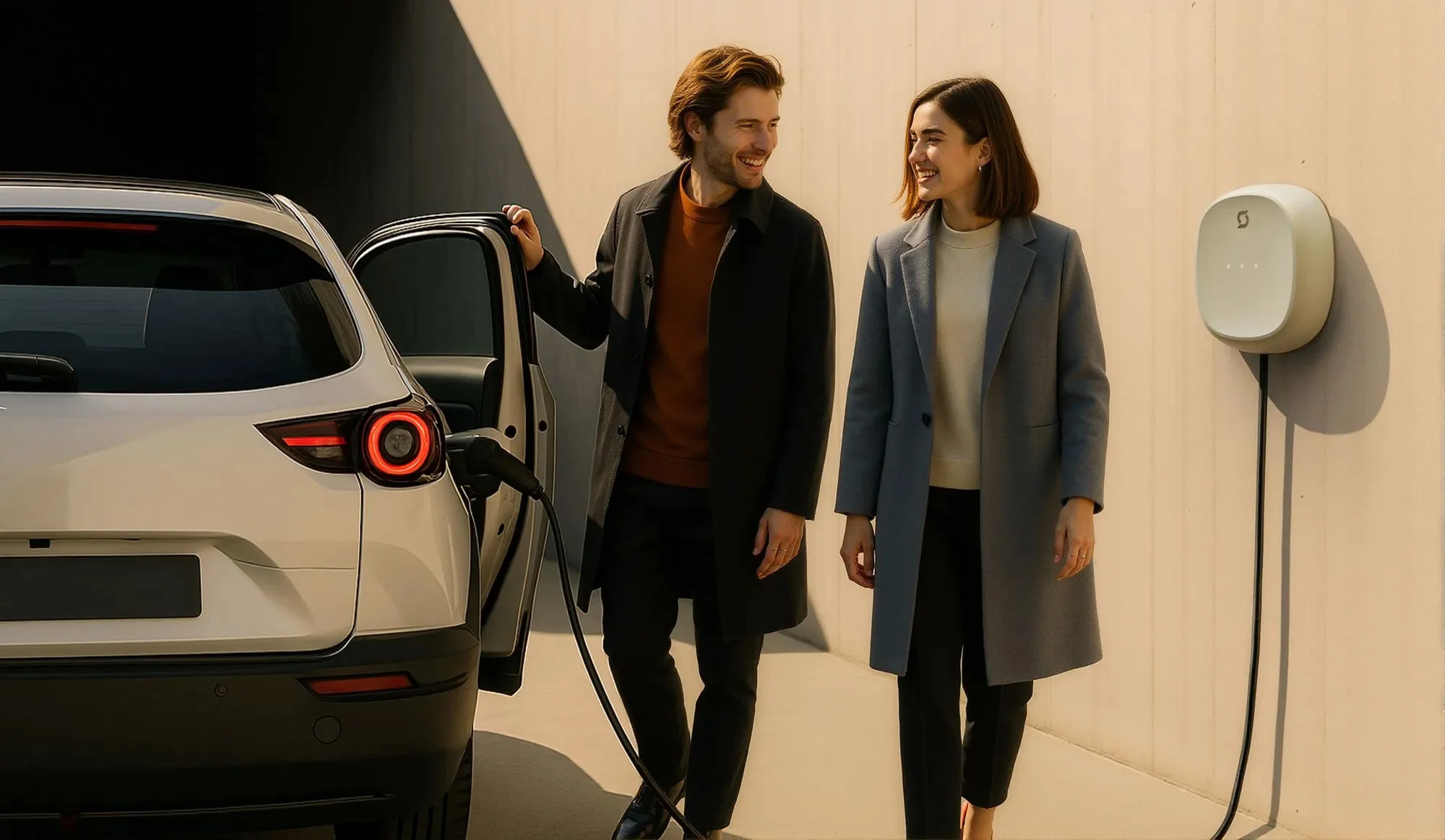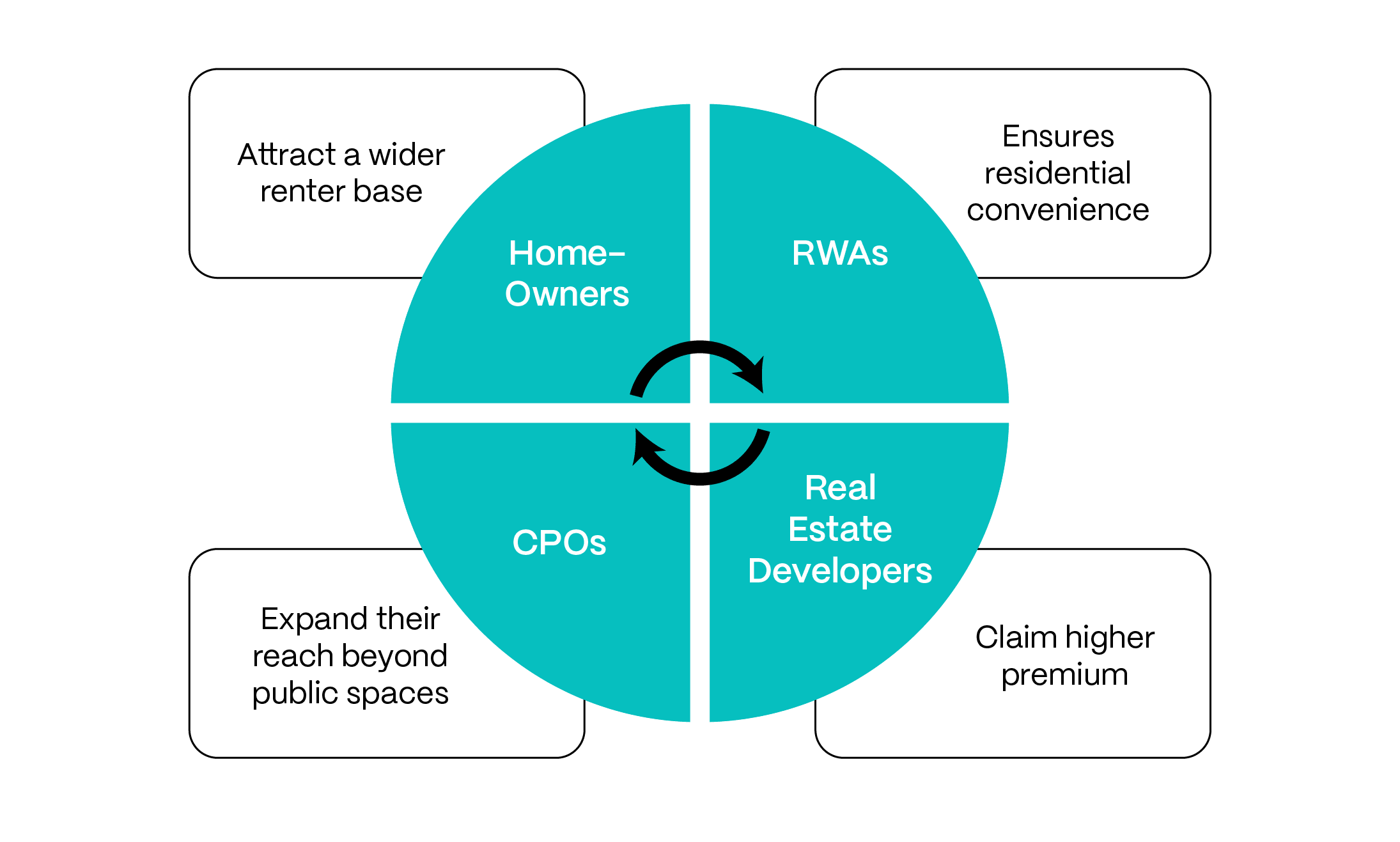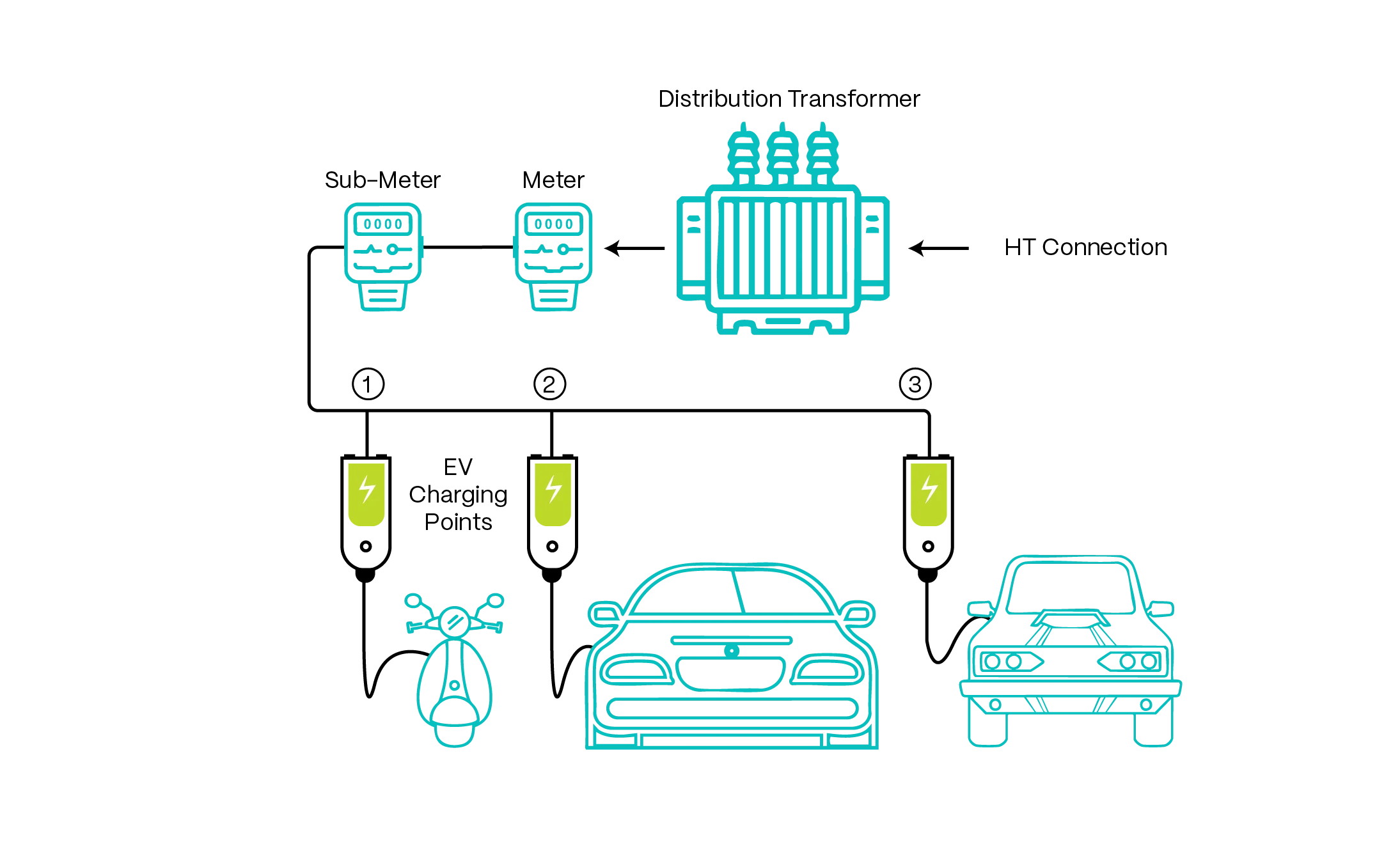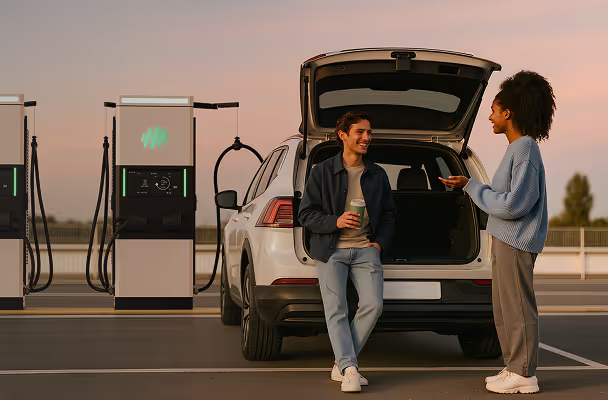Home EV Charging – a strategic imperative for EV adoption

Welcome to the second episode of our blog series on ‘different shapes and forms of electric vehicle (EV) charging’. If workplace charging sparks your curiosity, have you ever wondered how EV owners manage charging at home or within their communities? Let’s explore why residential and community charging is key to everyday EV convenience.
India is seeing a surge in EV (electric vehicle) sales. We saw over 1.67 million EV sales in FY24, and this number is only set to rise. However, EV charging infrastructure is one main hurdle in making the whole EV experience convenient. With around 80% of EV charging happening at home, accessible, safe, and smart charging infrastructure in residential areas is key to mass adoption. Without convenient home charging, range anxiety and dependency on public charging remain major bottlenecks. Integrating EV-ready infrastructure at home addresses both cost and convenience barriers, making EV ownership practical and scalable.
EV adoption is curtailed due to charging inconvenience
"Charging convenience is a key barrier to EV adoption - over 42% of potential buyers delayed their decision due to lack of chargers, while many existing users cite charging access as a major issue. In densely populated Indian cities, the absence of home or community chargers further discourages uptake."
Let’s admit, early home charging solutions were not very convenient. Early adopters often relied on 15A wall sockets, which were slow and unsafe for long-term use. The lack of designated charging points created operational hassles. RWAs of many Indian housing complexes did not having scope for EV charger installations, which further deterred potential buyers.
But all of that is a thing of the past now.
Today, we see a massive improvement in home EV chargers. Many of the erstwhile challenges of speed, convenience, longevity and safety, have been overcome through technological developments.
Policy support for home EV charging has become very strong too. EV charging has already been made a de-licensed activity. Central and state directives are offering discounted electricity rates, accelerating connection requests and are even subsidising charger installation.
All of this is aimed at making home EV charging more accessible. The perceived ‘hassle’ of installing a home EV charger is practically non-existent, given the convenience that comes from installing it.
Home EV chargers drive affordable convenience
With smart home EV charging, residents can charge their vehicles overnight, just like a mobile phone. This provides autonomy, avoids queues at public stations, and ensures full-range readiness every morning.

Here’s a quick look at the Trends in Home Charging:
- Shifting to Level 2 home EV chargers ensured stability and safety
Level 2 chargers (3.3–7.4 kW) deliver full overnight charging, are weatherproof, tamper-resistant, and include surge protection, auto cut-off, and load management features. ARAI and BIS now recommend EVSE (electric vehicle supply equipment) over legacy wall sockets to avoid fire and electrocution risks. - Smart Chargers enabled integration with home systems
Smart chargers can be monitored and controlled remotely through apps. Users can schedule charging, receive usage analytics, and enable or disable sessions through phone authentication or RFID. These systems integrate with OCPP (Open Charge Point Protocol) platforms, allowing flexible billing and energy optimization - Solar compatible home EV chargers reduced costs and load
Pairing EV chargers with rooftop solar and home batteries reduces emissions and costs. Projects like Lodha’s smart townships offer integrated solar-EV charging setups. Some villas in Hyderabad now advertise "EV solar-charging-ready homes”. - Technologies like V2G have the potential to create passive income for EV users
Smart chargers can potentially defer charging to off-peak hours, integrate time-of-day tariffs, and could participate in demand response programs. Emerging V2G pilots—such as the one in Kerala using Tata Nexon EVs - could enable users to sell stored energy back to the grid, enhancing grid resilience while opening up a possible additional income stream.
These changes in the Home EV charging environment are making it way more convenient and delivering humongous benefits to residential EV users, across financial, environmental and convenience aspects.
The convenience of home charging benefits many stakeholders
The prevelance of high-quality home EV charging will be beneficial to homeowners, renters, communities and real estate developers. Such benefits are especially enhanced in setups housing multi-family communities.
1.Homeowners can attract a wider renter base
Societies with EV infrastructure enjoy a 3–5% higher resale and rental value, and newer EV-ready buildings sell 15% faster. Buyers increasingly prioritize EV-readiness when shortlisting homes.
2.Real Estate developers can drive higher premium
EV charging is now viewed on par with lifts and clubhouses. Properties that advertise EV charging provision attract premium buyers. Tata Power and Lodha have partnered to deliver 100% EV-ready projects in Mumbai and Pune. This facility leads to asset differentiation and value enhancement. – and hence price premium for Real Estate.
Undoubtedly, future-ready buyers and tenants find EV charging facility attractive.
67% of urban millennials consider EV-readiness a key decision factor. Projects with EV infra see higher occupancy and lower churn, especially among premium rentals.
Then there’s the charm of new revenue streams and amenity-driven business models.
Builders and societies can lease charging bays to CPOs, charge service fees, or bundle EV charging in premium packages. In commercial real estate, this is already yielding monthly revenues upwards of ₹50,000 for buildings with heavy footfall.
3.CPOs can expand their reach beyond public spaces
CPOs like Tata Power EZ Charge, Fortum, and Charge+Zone are aggressively pursuing residential partnerships. Smart chargers in gated communities provide usage data, enable grid load optimization, and create cross-selling opportunities. CPOs often offer capex-free installations, recovering costs through revenue-share or per-kWh billing. They can also tap into regular user bases to build data-driven service models and cross-partnerships.

With Home EV Charging being so beneficial to all the parties concerned, it’s almost certain to take off. What’s holding it back?
The answer is – they need upfront planning and investment.
Let’s unravel the set-up considerations.
Home EV charging setups need planning and investment
EV charging setups, like any essential infrastructure, need to be invested in upfront. Since space, capital, technology and connectivity are critical – there needs to be coordinated efforts by:
- Real estate players
- RWAs (Resident Welfare Associations)
- CPOs (Charge Point Operators)
Working together, these players can accelerate high-quality home charging EV infrastructure.
How to do this?
- Developers should include EV charging space in the master plan
Ideally, Builders must integrate EV conduits during construction to save later costs. Amended Model Building bylaws recommend 20% of parking spaces be EV-ready. Builders in Mumbai, Bengaluru, and Hyderabad are now provisioning ducting, wiring, and panel boards from day one. - RWAs should have an upgrade plan
Unfortunately, older societies lack spare load and parking retrofits are costly. To overcome this, RWAs can pilot shared chargers, then scale based on usage. Load assessments, cabling provisions, and backup planning can be phased in. RWAs can start with 1-2 chargers, monitor usage, and expand incrementally. - Installation costs can should be recovered using shared revenue model
Many CPOs offer "install now, pay later" or lease models. RWAs can rent space to providers who recover costs through charging fees. Delhi’s EV policy allows DISCOMs to subsidize charger costs. - Separate metering can reduce charging costs
Large apartment complexes typically have a high sanctioned load and exclusive DTs for their own HT connections. In these situations, DISCOMs can use "minus metering" to provide an exclusive electricity connection for EV charging. An electrical connection can be drawn from the building’s existing HT connection directly and measured using a submeter. Upon that, the energy used for EV charging will be charged in accordance with relevant EV tariff. This method is simpler and less costly than creating a new LT connection for charging ports.

- Billing fairness should be ensured by using OCPP compliant EV chargers
A community EV charger will be used by multiple people. OCPP (Open Charge Point Protocol) prevents discrepancies in user billings by securely communicating charging data between the EV charger and central management systems. This standardization allows RWAs and CPOs to implement monitoring, access control, and transparent billing mechanisms. OCPP compliant EV chargers also support features like remote diagnostics and user logs. This enhances accountability and helps maintain trust among residents who are using shared charging infrastructure. - Grid load should be optimized by dynamic scheduling
Smart chargers support dynamic load allocation, avoiding transformer trips. RWAs can set peak/off-peak limits. DISCOMs like BESCOM now offer night-time EV tariffs as low as ₹3.75/unit.
By working together in a planned manner, residents, builders and CPOs can create a seamless investment environment that will benefit everyone with enhanced convenience and home value.
But the question is – what will drive all parties to collaborate? This is where incentives and regulations can help.
Incentives and regulations will help accelerate Home EV Charging
Incentives are key to overcoming short-term capital barriers and enabling long-term adoption of home EV charging. Well-funded CPOs, backed by proactive local governments, can drive widespread residential installations. Central and state policies support this with subsidies of up to 80% on charger installation, reduced GST on EVSE, tax exemptions, and property tax rebates. The Ministry of Power and MoHUA’s 2023 guidelines recommend EV-readiness in new constructions, while states like Delhi, Maharashtra, and Gujarat lead with mandates for EV-ready parking in older buildings and streamlined approvals. Model policies also encourage DISCOMs to create dedicated EV billing categories, accelerating residential adoption.
Home EV charging will drive EV adoption
Home EV charging represents a win-win for all stakeholders: savings for residents, asset uplift for developers, revenue for CPOs, and emission reductions for society. With rising EV demand, falling hardware costs, and supportive policies, residential charging is no longer optional – it’s foundational to India’s electric future.

Discover our home EV chargers here.
FAQs:
1. Is it safe to charge my EV at home from a normal wall socket?
No, charging from a standard 15A socket is not advisable for regular use. It's slow and unsafe. Newer Level 2 EV chargers (3.3–7.4 kW) are safer, quicker, and feature built-in protection such as surge control and auto cut-off.
2. What are the advantages of having a smart EV charger at home?
Intelligent chargers support programmed charging, consumption tracking, app management, and even solar system integration. They can save on energy bills, enhance convenience, and make it possible to participate in grid schemes such as time-of-day tariffs.
3. Can I fit an EV charger into an apartment building or multibay car park?
Yes, but coordination with the RWA would be needed and could involve load assessment, cabling, and revenue sharing models. Capex-free installation is provided by most CPOs with billing and maintenance controlled through app-based platforms.
4. Are government policies favorable to home EV charging in India?
Yes. Charging of EVs is a de-licensed activity. Various state EV policies provide subsidies, concessional tariffs, and quick electricity connections for domestic EV charging installations.
5. In what way might charging of EVs impact the property value of your house or community?
Properties and communities with EV-compatible infrastructure command 3–5% more resale or rent value. For property developers, EV charging has emerged as a point of differentiation—alongside lifts and clubhouses—particularly with urban millennial consumers.
Glossary
80% of EV Charging Happens at Home
Statistic highlighting that most EV charging currently takes place at residential premises, making home charging infrastructure critical for EV adoption and convenience.
Auto Cut-Off
A built-in safety feature in modern EV chargers that automatically stops charging when the battery is fully charged or detects faults, preventing overcharging and electrical hazards.
Capex-Free Installations
Charging infrastructure deployment approaches where upfront capital expenditure is borne by Charging Point Operators (CPOs) or third parties, with costs recovered later through revenue-share or pay-per-use models, reducing financial barriers for property owners and RWAs.
Charging Point Operators (CPOs)
Specialized companies that install, operate, and maintain EV charging stations, often managing billing, maintenance, user access control, and helpdesk support for residential or shared charging networks.
Electrocution Risk
The potential danger of electrical shock if EV charging is done through makeshift or unsafe means like legacy wall sockets; addressed by using certified Electric Vehicle Supply Equipment (EVSE) complying with safety standards.
Electric Vehicle (EV)
A motor vehicle powered fully or partially by electric energy stored in rechargeable batteries, requiring specialized charging infrastructure.
Electric Vehicle Supply Equipment (EVSE)
Specialized electrical equipment that safely provides power to EVs for charging, including chargers, cables, connectors, and control systems. Recommended by authorities like ARAI and BIS over legacy sockets.
Load Management
Smart charger features or infrastructure capabilities designed to balance electrical load on circuits and grids by scheduling, modulating power draw, or limiting simultaneous charging to prevent electrical overloads.
Legacy Wall Sockets
Conventional electrical outlets not designed for EV charging, posing safety and performance risks; their usage is discouraged by regulators.
Multi-Family Communities
Residential complexes or apartment societies with multiple households, commonly managed by Resident Welfare Associations (RWAs), often requiring shared or managed home charging infrastructure.
Open Charge Point Protocol (OCPP)
An open communication protocol supported by smart chargers allowing interoperability between charging stations and management software, enabling real-time monitoring, fair billing, remote administration, and user authentication.
Passive Income through V2G
Potential earnings EV owners may get by selling stored battery energy back to the grid in Vehicle-to-Grid (V2G) programs, demonstrated by pilot projects like Kerala’s Tata Nexon EV initiative.
Resident Welfare Association (RWA)
The governing body of multi-family residential communities responsible for management of common infrastructure, amenities, and shared resources—critical stakeholders in planning, hosting, and managing home EV charging networks.
Revenue-Share Model
A financial agreement where CPOs install and operate EV chargers with zero or minimal upfront cost to RWAs or property owners, recovering expenses by sharing charging revenue or through usage-based billing (per kWh).
RFID Authentication
A wireless identification technology used in smart chargers to authenticate authorized users before permitting charging, enhancing security and management in shared residential setups.
Scheduling Charging
The ability of smart chargers to enable users or system managers to define specific time windows for charging, commonly during
Bibliography: Authority Sources on Home EV Charging in India
- Ministry of Power (MoP)
Charging Infrastructure for Electric Vehicles – Revised Guidelines & Standards, 2022 & 2024 updates.
- Delhi Dialogue and Development Commission (DDC)
Residential EV Charging Guidebook for RWAs (2022) – Developed with DISCOMs and WRI India.
- World Resources Institute (WRI) India.
Enabling Residential EV Charging Infrastructure in India – Policy briefings and community models.
- Automotive Research Association of India (ARAI)
EVSE Safety Guidelines for Residential and Commercial Use (2023)
- Central Electricity Authority (CEA)
EV Tariff Rationalisation and Load Forecast Reports (2022–2025)
- Adani Electricity Mumbai Ltd
Share Charge Initiative – EV charging in housing societies (2023–24)
- Tata Power EZ Charge
EV Infrastructure Projects in Residential Communities
- Lodha Group
Sustainability and EV-Ready Townships – Press releases and project brochures.
- NoBroker EV Survey Report (2023)
Changing Preferences of Indian Urban Homebuyers and Tenants Regarding EV Infrastructure
- Saur Energy International
India’s First Vehicle-to-Grid Pilot in Kerala using Tata Nexon EVs (2024)
- MyGate
Resident-Facing EV Charging Playbooks for Housing Societies
- BESCOM & TANGEDCO.
Time-of-Day (ToD) Tariff Schedules and EV Charging Connections – State DISCOM circulars
Frequently Asked Questions
Lorem ipsum dolor sit amet, consectetur adipiscing elit, sed do eiusmod tempor incididunt ut labore et dolore magna aliqua. Ut enim ad minim veniam, quis nostrud exercitation ullamco laboris nisi ut aliquip ex ea commodo consequat. Duis aute irure dolor in reprehenderit in voluptate velit esse.
Lorem ipsum dolor sit amet, consectetur adipiscing elit, sed do eiusmod tempor incididunt ut labore et dolore magna aliqua. Ut enim ad minim veniam, quis nostrud exercitation ullamco laboris nisi ut aliquip ex ea commodo consequat. Duis aute irure dolor in reprehenderit in voluptate velit esse.
Lorem ipsum dolor sit amet, consectetur adipiscing elit, sed do eiusmod tempor incididunt ut labore et dolore magna aliqua. Ut enim ad minim veniam, quis nostrud exercitation ullamco laboris nisi ut aliquip ex ea commodo consequat. Duis aute irure dolor in reprehenderit in voluptate velit esse.
Lorem ipsum dolor sit amet, consectetur adipiscing elit, sed do eiusmod tempor incididunt ut labore et dolore magna aliqua. Ut enim ad minim veniam, quis nostrud exercitation ullamco laboris nisi ut aliquip ex ea commodo consequat. Duis aute irure dolor in reprehenderit in voluptate velit esse.
Lorem ipsum dolor sit amet, consectetur adipiscing elit, sed do eiusmod tempor incididunt ut labore et dolore magna aliqua. Ut enim ad minim veniam, quis nostrud exercitation ullamco laboris nisi ut aliquip ex ea commodo consequat. Duis aute irure dolor in reprehenderit in voluptate velit esse.




